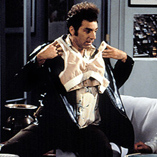Well over a decade ago, Comedy Central showed a particular stand-up comedy routine (quite regularly it seemed, based on the number of times I stumbled upon it) where the comedian did a bit about China's enormous population. "Can you believe it? A billion people. A billion! Do you realize what that means? You can be a one-in-a-million guy (pause, for dramatic effect). But guess what? There are a thousand others out there who are just like you!"
As marketers, when we drive the messaging for a product or solution, we are always faced with the challenge of finding the one-in-a-million person who has a need for our solution. We often think in terms of segments—geography, gender, age, technological expertise, household makeup—that are easily actionable. A workshop I recently attended defined a segment more elegantly, though not necessarily in a way that immediately translates into action. According to the facilitator, a segment is any group of individuals sharing a common problem. Bridging the gap from the "segment as people with common problem" to "segment where we can message effectively" depends on data and analytics, intelligently applied to reach our one-in-a-million target segment.
Let's stick with comedy and work our way through a hypothetical example. Dedicated "Seinfeld" fans no doubt remember an episode in which Frank Costanza and Kramer decide to go into business developing and selling an upper-body support product for men. It's not a bra (Kramer: "A bra is for ladies."); it's a Bro, though Frank wanted to call it a Man-ssiere. So Kramer and Frank are ready to market the Bro. What next? Well, not surprisingly, the show didn't get far into the marketing plan, undoubtedly due to the time constraints of the 30-minute sitcom format. If they'd had an hour, a detailed segmentation would clearly have resulted. In its absence, I will seek to fill the void.
If we think of our segment as those who share a common problem, the Bro solves a dilemma for men who need additional upper-body support due to sagging pectorals (insert amusing slang here). I did some checking, and among major data providers there are no pre-defined selection criteria or targeted lists for "Men with Sagging Pectorals," so logical use of typical data available is in order. Note: After we have some success in the market and have built a customer file, we'll be able to build analytic models to find look-alikes. In the meantime, we'll use assumptions to drive the plan:
• We know we are targeting males. It's a Bro, not a bra.
• We will assume that the proportion of males with sagging pectorals increases as men age beyond 50.
• We will also assume that the Bro functions as a nice-to-have rather than a necessity. So, early on, we will target those whom we believe have discretionary dollars to dedicate to the extra comfort associated with upper-body support.
As we apply these selects to roughly 300 million U.S. individuals, we begin to close in on a targetable segment. Using the three criteria above reduces our target list to 5 million individuals—so far, so good. But any hack marketer could probably have gotten this far. Now the heavy lifting begins. How do you reach this target group? And how do you maximize the effect of the campaign for near-term and long-term gain?
1. Analyze the target list of 5 million geographically. Is there an unusually high concentration of the target population in particular DMAs (Designated Market Areas)? Such information can unlock opportunities for targeted mass advertising in cities or even neighborhoods via newspapers, billboards, TV or radio.
2. Analyze the list against syndicated research information. Based on your target list, what stores do these men frequent? What do they like to read? When they buy clothing and accessories, do they do their own buying? Or is someone buying for them? Attitudinally, is there a way to delineate those who would be embarrassed at the idea of buying a Bro versus those who would not? Or perhaps to identify those who would gladly buy a Bro via the relative anonymity of mail or email/online versus those who would prefer a more personalized fitting experience at their favorite retail outlets? There may even be opportunities for partnership/affinity marketing that are uncovered via ties to syndicated data. To what organizations do these individuals belong?
3. Now dig further. By whom are those on the target list influenced? And who on the target list is an active influencer? There may not be many active Twitter users on the Bro target list, but it would not be surprising at all, based on the most recent statistics, to find that there are some very active Facebook users on the target list. Status Update: "Just bought the Bro the other day on a lark. Wore it today for the first time and it feels GREAT. You can't believe the difference it makes. Shot four strokes below my average today at the club, too."
Most importantly, after the first wave of marketing, re-evaluate everything. Look at who actually bought the Bro. What are their characteristics? Were there anomalies in the target we did not anticipate? Were there particular tactics that were notably more effective than others? Are there opportunities to expand the line to address adjacent problem spaces that aren't being perfectly addressed by the Bro?
Marketing doesn't need to be hard. But it does require a combination of logical thinking, willingness to utilize available data and ability to perform analysis. Otherwise, we're just guessing. And when it comes to finding the one-in-a-million guy that has the problem our product solves, guessing just won't cut it. Information is key. Even when there's no data available that specifically addresses the issue, a combination of logical assumptions, data and analysis can yield highly-targeted, actionable segments for messaging.
David Danziger is senior manager of innovation at Acxiom Corporation. He loves "Seinfeld," but he does not wear a Bro. Yet.



